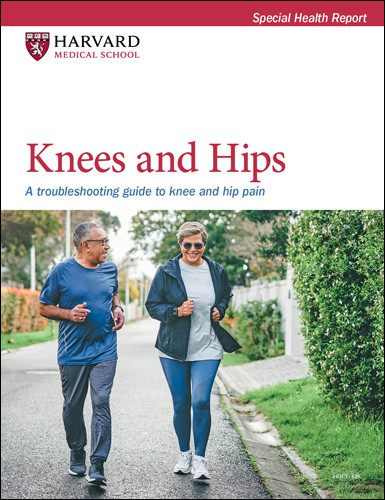Do these activities hurt your knees?
Certain activities probably won't cause damage, but they might sideline you with pain. Here's what you can do to stay active.
- Reviewed by Anthony L. Komaroff, MD, Editor in Chief, Harvard Health Letter; Editorial Advisory Board Member, Harvard Health Publishing

Running, squatting, kneeling, stair climbing, bike riding, jumping around in an aerobics class — these activities all require your knees to bend repeatedly and take a pounding. Does that stress wind up hurting the joints?
Certain activities can indeed lead to knee pain or arthritis flare-ups. But evidence suggests that regular activity or exercise is unlikely to cause actual knee damage or accelerate knee osteoarthritis (the wearing away of cartilage that cushions the bones). In fact, activity is essential for knee health.
How activity protects the knees
If you've heard the phrase "motion is lotion," it means that activity helps keep you going. And that's certainly true for the knees. Knee cartilage requires regular "loading" or force placed on it to stay healthy, whether that comes from taking a brisk walk or squatting to get something from a low cabinet.
And when you exercise, your knees get a cascade of benefits. "Exercise not only keeps knee cartilage healthy, but also builds muscle strength, which is important to stabilize the joint. In addition, exercise helps the knee maintain range of motion, decreases knee stiffness, and can contribute to improved function and quality of life." says Dr. Dayna Yorks, an instructor in physical medicine and rehabilitation at Harvard Medical School.
Many studies suggest there's no link between running, jogging, or walking and the development or progression of knee osteoarthritis. For example, a 2018 study suggested the rate of knee and hip arthritis in marathon runners was half that of the general U.S. population. And a 2022 review of 24 studies found no evidence of harm to knee cartilage thickness among people who'd just gone for a run.
How do activities hurt the knees?
Despite the benefits of activity, certain movements can still cause pain in healthy knees or irritate already arthritic knees.
For example: "Some activities stress the knee joint more than others, such as doing a deep squat, kneeling, or even going up or down stairs. These activities can be especially painful if you have more severe arthritis and weakness in the muscles around the joint," Dr. Yorks says.
Other activities that put excessive force on your knee and might cause pain or an arthritis flare include
- riding a bike with a seat so low that your knee has to bend excessively
- jumping or bounding a lot in an aerobics class
- going for a long run on a trail with uneven surfaces.
How to keep moving
To reduce or avoid knee pain, modify your movement — especially if pain starts — to ease pressure on the joints. Here are ways to do that for specific activities.
Stair climbing. Take one step at a time: place your right foot on a step, then bring your left foot up to join it. Repeat the process up the staircase. "Hold the railing. As you climb, align your hip, knee, and ankle in one straight line and do not let your knee jut forward over your toes. Press your whole foot onto the step, not just the ball of your foot or your heel, to use all of the muscles of the ankles, legs, and buttocks," Dr. Yorks says.
Aerobics routines. "If your routine includes a jumping jack, do a toe tap instead," Dr. Yorks suggests. "If everyone is doing lunges but a squat feels better on your knee, do a small squat or something else that targets the same muscles the class is working on."
Running. Run at a slow speed and for a short distance. Avoid hard pavement; look instead for a surface with a little more give, like a high school track that's open to the public in the evenings.
Sitting on the floor. Do you sit cross-legged as you play with your grandkids? If it hurts, put your legs out in front of you, separating them a little.
Kneeling. If you have to get down on your knees when you're cleaning a bathtub or gardening, you'll be more comfortable on a pad of some sort.
Squatting. Avoid deep squats if they cause pain. Instead, keep a small step stool handy and sit on it when you need to get low to the ground.
Walking. Consider using Nordic walking poles.
What if it still hurts?
If modifying an activity doesn't help, and pain is severe, then stop and monitor your symptoms.
If pain eases in a few hours, Dr. Yorks says it's okay to resume the activity. If pain persists, it's time to see your doctor. The prescription is often physical therapy.
"Our goal is to keep you moving, and you may need help to do that," Dr. Yorks says. "We can help increase physical activity based on your unique goals, and it will have positive effects on function, mood, and pain, often without medication. The key is staying active."
Image: © Image Source/Getty Images
About the Author

Heidi Godman, Executive Editor, Harvard Health Letter
About the Reviewer

Anthony L. Komaroff, MD, Editor in Chief, Harvard Health Letter; Editorial Advisory Board Member, Harvard Health Publishing
Disclaimer:
As a service to our readers, Harvard Health Publishing provides access to our library of archived content. Please note the date of last review or update on all articles.
No content on this site, regardless of date, should ever be used as a substitute for direct medical advice from your doctor or other qualified clinician.
















